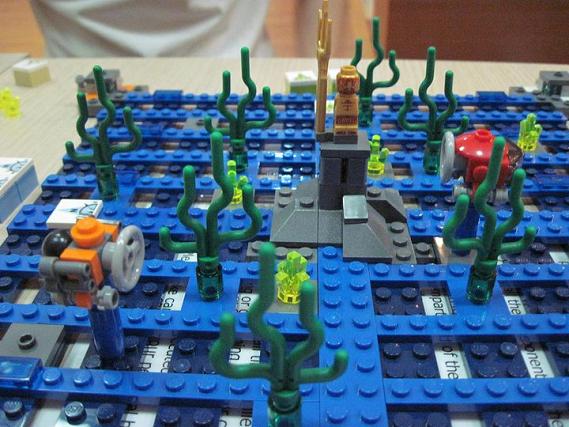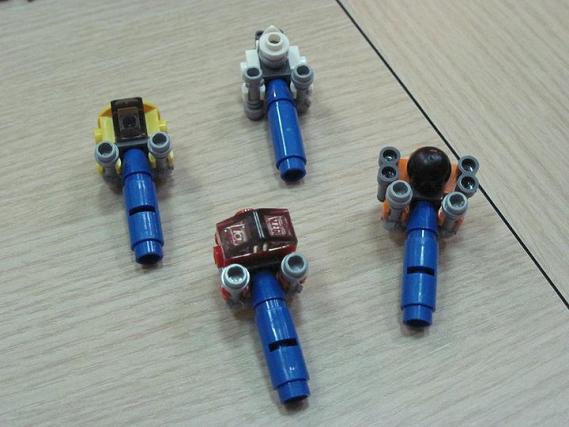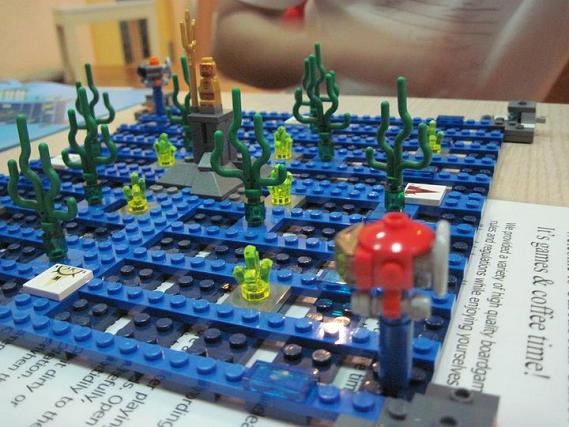
(Edit: A reader Brett has indicated that this review is inaccurate as we played with the wrong rules. Using the correct ones, it should be much harder to pick up treasure so the first player isn’t the predetermined winner. I’m still leaving this post up for posterity and I don’t know when I’ll be able to play this again. Thanks Brett!)
The first thing we saw when we checked back in at Carcasean after an absence of two weeks was Sean playing with LEGO bricks in his shop. It turned out that he’d bought it while visiting Italy, with the “it” being Atlantis Treasure, one of the entries in the relatively recent LEGO Games line of products. This is apparently LEGO’s attempt to break into the tabletop gaming market with games that are made entirely out of LEGO bricks.
Sean was just about finished assembling the bricks when we arrived so we decided that we might as well play it since it was already on the table. I didn’t expect much, but at least it would be short and I thought the little LEGO die with rubberized edge looked kind of neat. It turned out that the game was even worse than I expected. Note that I haven’t read the rules as Sean did all the reading and explaining, so I have no idea what the official terminology for all the components or mechanics are and I’m just substituting logical terms of my own for them.
As its name implies, the game is all about gathering up treasure from the bottom of the ocean. Each player controls a submarine that starts out on each corner of the “board” and can pick up treasure by simply moving to that location and stopping there. Each submarine is equipped with two torpedos that can be used to attack enemy submarines. In addition, the corals and the undersea structure in the middle serve to block movement. Finally, the game comes with a set of four movement tiles for each cardinal direction (north, south, east and west).
During game setup, each player chooses two of these movement tiles to keep. The way movement works is that you choose one lateral direction for your submarine to move in and you may move as many spaces as you wish. If you stop at a square with a tile, you may then continue moving in the direction indicated by that tile for as many extra spaces as you wish. This causes that tile to be returned to the supply for use.

In addition to normal movement, the included six-sided die indicates what special action is available to the player each turn. Four of the six side correspond to each of the four movement tiles. If you roll one of these, you can choose to either place any movement tile from your own reserve anywhere onto the board, or take one movement tile corresponding to the die result you get and either put it into your reserve or directly place it anywhere on the board.
The torpedo die result lets you shoot a torpedo, either before or after normal movement. You can blast away a blocking coral with it or destroy an enemy submarine in any lateral direction and at any range. If you do the latter, you get to send the unfortunate sub to any corner of your choice and you get to steal one of the owner’s treasures, if he has any. When you run out of torpedos, you need to move back to your own corner to get a refill. Finally, the last die result lets you choose one of the corals on the board to move to any location.
While all this doesn’t sound that bad on paper, in practice, it’s hard to imagine how anyone other than the starting player can win, given that the objective is to be the first to get to three treasures. Since every player starts with two movement tiles, everyone is practically guaranteed to be able to get a treasure on their first action. In the second round of our game, Sean then rolled the torpedo die result. Since you can shoot before or after movement, it’s pretty hard to find a situation in which you can’t shoot an enemy submarine, so down went my submarine, giving Sean two treasures and me zero. Predictably enough, Sean won on the third round by simply moving to a third treasure and claiming it.
I think the rulebook suggests some variants and the game even includes some extra components to change the rules a bit so it may not be a total loss. Offhand, I’d say that eliminating the two starting tiles each player gets should make it a more substantial, if more random, game. Even so, I don’t think this game can ever be entertaining to anyone other than very young children. I guess you could always salvage the bricks to make other stuff with, but that would make for a very expensive way just to get some LEGO bricks. So a solid thumbs-down from me on this one. Practically all the other kiddie games Sean had me try can do better than this.

4 Responses to “Atlantis Treasure”
Hi there!
I too have played Atlantis Treasure, and while it is definitely for kids, it’s not the train-wreck you are suggesting. Here’s why: You weren’t playing right – when you move your submarine you have to move it “as far as it can go” in the direction it’s heading, not, as you suggest “as many spaces as you wish”. I think you’ll find that makes a HUGE difference!!
Maybe you’ll give it another go?
Oops! my bad…
Thanks Brett, it really changes a lot :p
And i’ve added all the variant suggest at the back of the book, maybe we should play with the basic 1st :p
Haha, so Sean explained the rules wrongly. That does change a lot. It would make it a lot harder to pick up the treasure and it makes the corals more important as you need to use them to stop your movement I presume.
So how does picking up treasure work? Does a treasure in your path automatically stop your movement? I presume that passing over a movement tile changes your direction immediately?
Yes, just as you say, picking up treasures is much more tricky, and the corals reefs becomes more important since they block movement. Indeed, the only things that do stop movement are the corals reefs, the edge of the board, another submarine or stopping to pick up a treasure. And if you hit a compass tile you change direction immediately and just keep going!
Leave a Reply